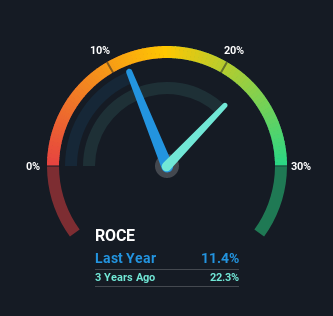There Are Reasons To Feel Uneasy About Chr. Hansen Holding's (CPH:CHR) Returns On Capital

If we want to find a stock that could multiply over the long term, what are the underlying trends we should look for? One common approach is to try and find a company with returns on capital employed (ROCE) that are increasing, in conjunction with a growing amount of capital employed. This shows us that it's a compounding machine, able to continually reinvest its earnings back into the business and generate higher returns. Having said that, from a first glance at Chr. Hansen Holding (CPH:CHR) we aren't jumping out of our chairs at how returns are trending, but let's have a deeper look.
Understanding Return On Capital Employed (ROCE)
For those who don't know, ROCE is a measure of a company's yearly pre-tax profit (its return), relative to the capital employed in the business. The formula for this calculation on Chr. Hansen Holding is:
Return on Capital Employed = Earnings Before Interest and Tax (EBIT) ÷ (Total Assets - Current Liabilities)
0.11 = €304m ÷ (€3.1b - €432m) (Based on the trailing twelve months to November 2021).
Thus, Chr. Hansen Holding has an ROCE of 11%. That's a relatively normal return on capital, and it's around the 12% generated by the Chemicals industry.
See our latest analysis for Chr. Hansen Holding

Above you can see how the current ROCE for Chr. Hansen Holding compares to its prior returns on capital, but there's only so much you can tell from the past. If you're interested, you can view the analysts predictions in our free report on analyst forecasts for the company.
What Can We Tell From Chr. Hansen Holding's ROCE Trend?
On the surface, the trend of ROCE at Chr. Hansen Holding doesn't inspire confidence. Over the last five years, returns on capital have decreased to 11% from 20% five years ago. However, given capital employed and revenue have both increased it appears that the business is currently pursuing growth, at the consequence of short term returns. If these investments prove successful, this can bode very well for long term stock performance.
In Conclusion...
Even though returns on capital have fallen in the short term, we find it promising that revenue and capital employed have both increased for Chr. Hansen Holding. In light of this, the stock has only gained 27% over the last five years. Therefore we'd recommend looking further into this stock to confirm if it has the makings of a good investment.
If you'd like to know about the risks facing Chr. Hansen Holding, we've discovered 1 warning sign that you should be aware of.
For those who like to invest in solid companies, check out this free list of companies with solid balance sheets and high returns on equity.
If you're looking to trade Chr. Hansen Holding, open an account with the lowest-cost platform trusted by professionals, Interactive Brokers.
With clients in over 200 countries and territories, and access to 160 markets, IBKR lets you trade stocks, options, futures, forex, bonds and funds from a single integrated account.
Enjoy no hidden fees, no account minimums, and FX conversion rates as low as 0.03%, far better than what most brokers offer.
Sponsored ContentNew: AI Stock Screener & Alerts
Our new AI Stock Screener scans the market every day to uncover opportunities.
• Dividend Powerhouses (3%+ Yield)
• Undervalued Small Caps with Insider Buying
• High growth Tech and AI Companies
Or build your own from over 50 metrics.
Have feedback on this article? Concerned about the content? Get in touch with us directly. Alternatively, email editorial-team (at) simplywallst.com.
This article by Simply Wall St is general in nature. We provide commentary based on historical data and analyst forecasts only using an unbiased methodology and our articles are not intended to be financial advice. It does not constitute a recommendation to buy or sell any stock, and does not take account of your objectives, or your financial situation. We aim to bring you long-term focused analysis driven by fundamental data. Note that our analysis may not factor in the latest price-sensitive company announcements or qualitative material. Simply Wall St has no position in any stocks mentioned.
About CPSE:CHR
Chr. Hansen Holding
Chr. Hansen Holding A/S, a bioscience company, develops natural ingredient solutions for the food, nutritional, pharmaceutical, and agricultural industries in Europe, the Middle East, Africa, North America, Latin America, and the Asia Pacific.
Adequate balance sheet average dividend payer.
Similar Companies
Market Insights
Community Narratives



